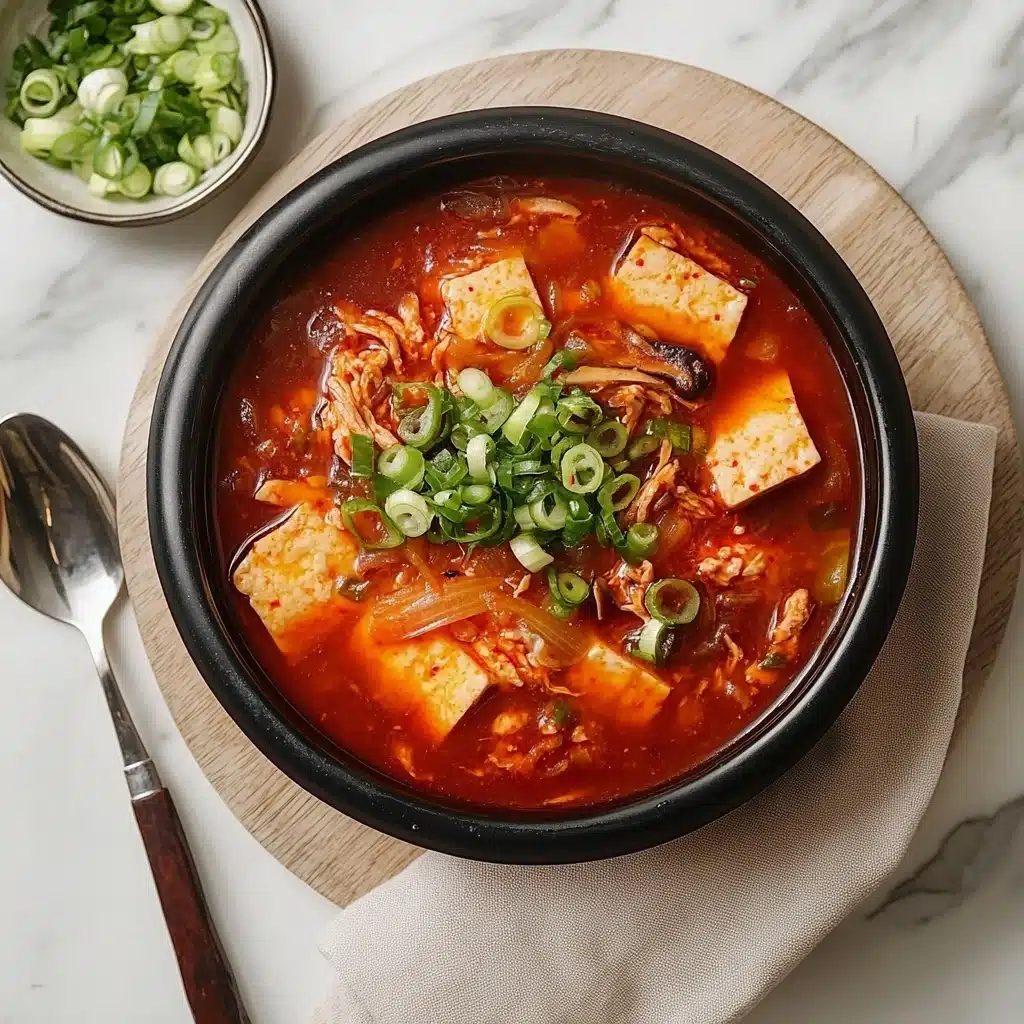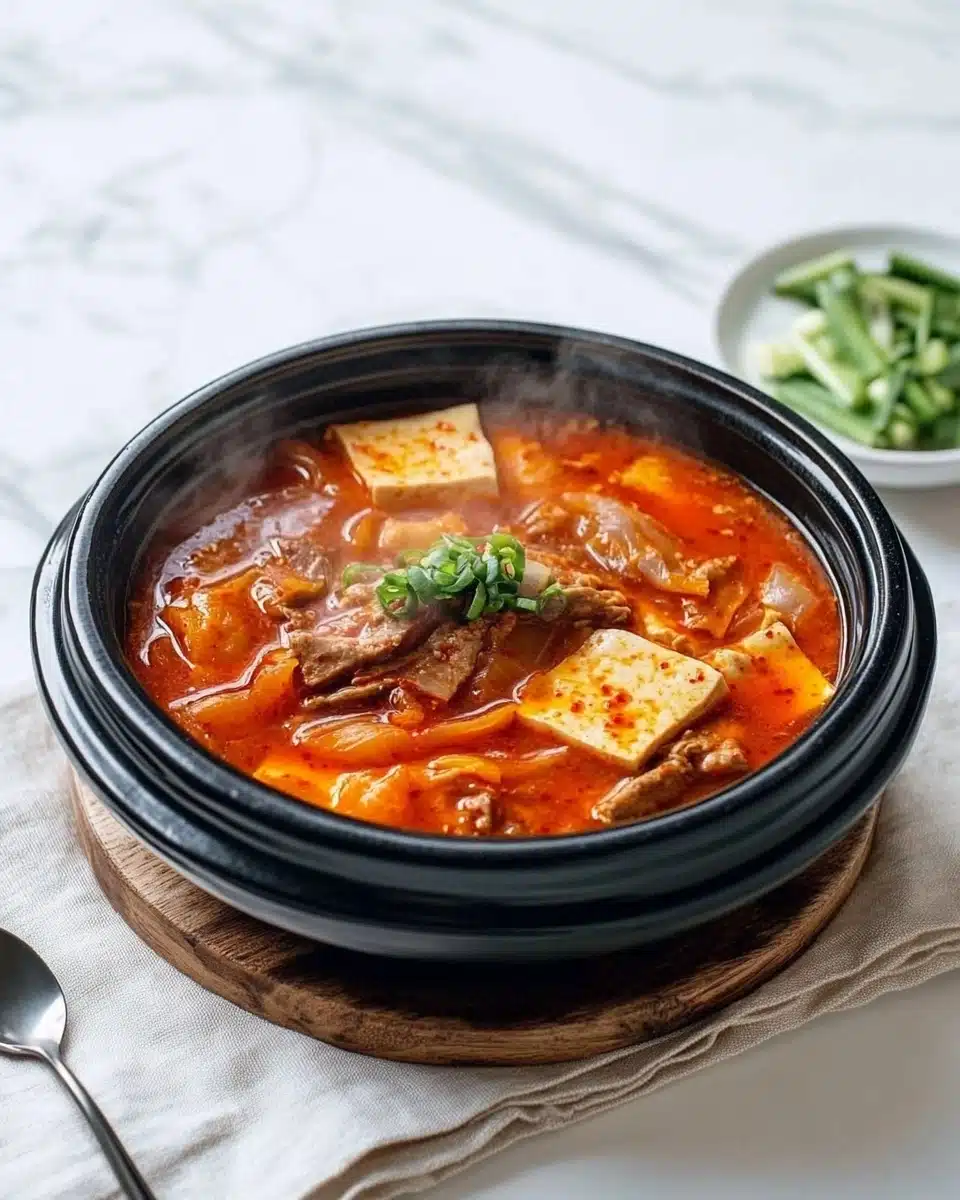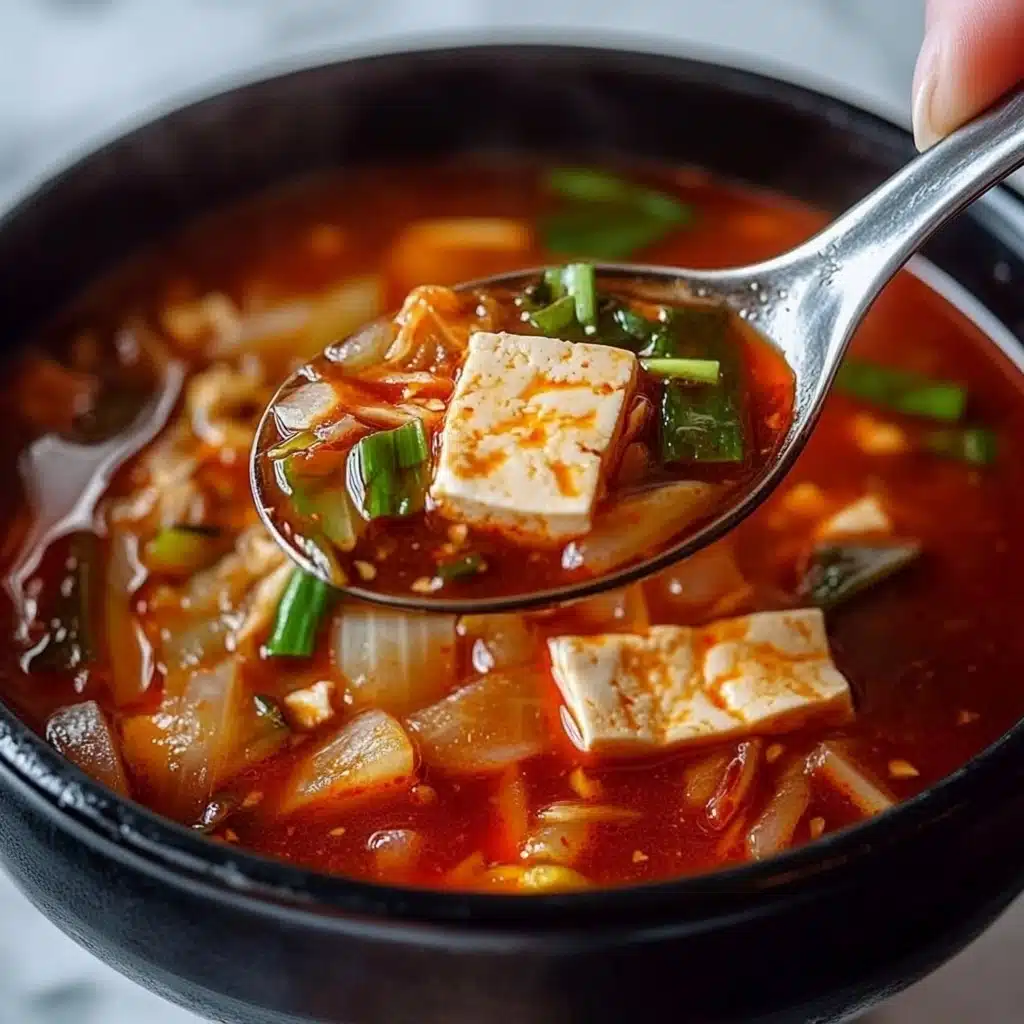If you’re seeking a warm, comforting dish perfect for all seasons, then you’ll absolutely fall in love with Kimchi Stew (Kimchi Jigae Recipe). Packed with bold flavors and a delightful spicy kick, this dish is a staple in Korean households for a reason. It’s deliciously soul-soothing, hearty, and incredibly easy to make.
Why You’ll Love This Recipe
- Comfort in a Bowl: Each bite is like a warm hug, ideal for cozying up on chilly days.
- Loaded with Flavor: The combination of kimchi, gochujang, and chili flakes brings a delightful depth that’s hard to resist.
- Versatile and Easy: This dish can be easily tailored to suit your taste with different proteins or made vegetarian.
Ingredients You’ll Need
Creating this delicious Korean delight doesn’t require an extensive list of hard-to-find ingredients. Here’s a lineup of simple yet essential items that come together to make Kimchi Stew (Kimchi Jigae Recipe) a weekday favorite.
- 1 tablespoon oil: Essential for sautéing and adding a bit of richness to the base flavors.
- 1 onion (thinly sliced): Adds sweetness and depth, forming the aromatic foundation of the stew.
- 3 cloves garlic (sliced): Infuses the stew with its fragrant and unmistakable punch.
- 8 ounces pork belly or shoulder (225g, thinly sliced): The marbled fat enhances the stew’s savory notes.
- 1 pound kimchi (450g, with juices, chopped): The star of the dish, providing that iconic spicy, tangy taste.
- 1 teaspoon salt: Balances the flavors and enhances the stew’s depth.
- 2 teaspoons sugar: A touch of sweetness to counteract the acidity of the kimchi.
- 1 tablespoon Korean chili flakes: Delivers a subtle heat to warm you from the inside out.
- 1 tablespoon gochujang (Korean red pepper paste): Offers a savory, spicy kick while also thickening the stew.
- 3 cups chicken stock (700 ml): Provides a rich base for the stew; fish or beef stock can also be used.
- 8 oz. firm tofu (225g, cut into 1/4-inch thick slices): Absorbs all the flavors beautifully, adding a unique texture.
- 1 teaspoon sesame oil: Finishing touch that boosts aroma and flavor.
- 1 scallion (chopped): Fresh and vibrant, used as a garnish to add color and brightness.
Variations
One of the joys of cooking is making a dish your very own. Here’s how you can personalize your Kimchi Stew (Kimchi Jigae Recipe) to fit your taste and dietary preferences, effortlessly adjusting based on what you love or have on hand.
- Make it Vegetarian: Omit the pork and add more tofu or mushrooms for a hearty, meat-free option.
- Seafood Twist: Add shrimp or clams for a delightful oceanic flavor that pairs beautifully with kimchi.
- Spice Level: Adjust the amount of gochujang and chili flakes based on your heat tolerance.
How to Make Kimchi Stew (Kimchi Jigae Recipe)
Step 1: Sauté the Aromatics
In a large pot, heat the oil over medium-high heat. Add the onion, garlic, and pork belly. Cook for about 5 minutes, ensuring the pork browns nicely and the onions soften, releasing their fragrance, setting the savory stage for your stew.
Step 2: Incorporate Kimchi and Broth
Add the kimchi and let it sizzle for a couple of minutes before incorporating the salt, sugar, chili flakes, and gochujang. Stir it all together, allowing the spices to coat the ingredients thoroughly before pouring in your choice of stock. Bring everything to a simmer, cover, and cook for 10 minutes to let the flavors meld.
Step 3: Finish the Stew
Uncover your pot and lay tofu slices over the top. Cover and simmer for another 10 minutes, letting the tofu soak up the delicious broth. Finally, uncover and drizzle sesame oil in, giving it a final fragrant touch. Sprinkle with chopped scallion before serving hot with steamed rice.
Pro Tips for Making Kimchi Stew (Kimchi Jigae Recipe)
- Aged Kimchi: For the fullest flavor, use kimchi that has been fermenting for at least a few weeks.
- Stock Selection: The choice of stock significantly impacts the flavor; beef stock gives a richer taste, while chicken offers a lighter base.
- Tofu Texture: Opt for firm tofu to maintain its shape and absorb the flavorful broth effectively.
- Layering Flavors: Sear your kimchi for a moment in the pan to deepen its flavors before adding liquids.
How to Serve Kimchi Stew (Kimchi Jigae Recipe)

Garnishes
A touch of chopped scallion does wonders for enhancing the stew with a fresh, vibrant crunch. You can also add a sprinkle of sesame seeds for nuttiness and visual appeal.
Side Dishes
Kimchi stew pairs exceptionally well with steamed rice, which helps balance its savory, spicy notes. Consider serving it with Korean side dishes like pickled radishes or sautéed spinach for a full Korean meal experience.
Creative Ways to Present
Try serving the stew in small clay pots for an authentic Korean presentation that keeps the dish warm throughout the meal. Alternatively, use a large, shared bowl in the center of the table for a family-style service.
Make Ahead and Storage
Storing Leftovers
Leftover kimchi stew keeps well in an airtight container in the refrigerator for up to three days. The flavors intensify as they meld, making it even tastier upon reheating.
Freezing
To freeze, ensure the stew cools completely, then transfer it to a freezer-safe container. It can be stored for up to three months. Thaw overnight in the fridge before reheating.
Reheating
Reheat the stew gently over medium heat on the stovetop. Adding a splash of water or stock can help revive the flavors as they reheat. Ensure it’s hot all the way through before serving.
FAQs
-
Can I make Kimchi stew less spicy?
Absolutely! Reduce the amount of gochujang and chili flakes, or substitute these ingredients with milder options to control the spice level to your preference.
-
Is there a vegetarian option for this recipe?
Yes! You can skip the pork and substitute the chicken stock with vegetable broth. Add more tofu or include various mushrooms for added flavor and texture.
-
What other proteins can I use instead of pork?
Poultry or beef work well as substitutes, or even seafood like shrimp or fish, to create different variations of the stew each time you cook it.
-
Can I use kimchi that isn’t fully fermented?
Yes, but for the best flavor, ensure it’s at least a few weeks old. This gives the stew that distinctively tangy and robust profile that makes it so enjoyable.
Final Thoughts
If you’re craving a dish that’s hearty, rich, and packed with flavor, dive into making this Kimchi Stew (Kimchi Jigae Recipe). It’s a versatile dish that promises comfort with each spoonful and provides ample opportunity for customization. I can’t wait for you to try it!
Print
Kimchi Stew (Kimchi Jigae Recipe) Recipe
- Prep Time: 10 minutes
- Cook Time: 30 minutes
- Total Time: 40 minutes
- Yield: 6 servings
- Category: Soup
- Method: Simmering
- Cuisine: Korean
Description
Kimchi Jjigae is a hearty, spicy Korean stew that combines fermented kimchi, pork, tofu, and flavorful seasonings. This comforting dish is quick to prepare and perfect for cold days, offering a rich blend of tangy and spicy flavors with tender pork and silky tofu, served over steamed rice for a complete meal.
Ingredients
For the stew
- 1 tablespoon oil
- 1 onion (thinly sliced)
- 3 cloves garlic (sliced)
- 8 ounces pork belly or shoulder (225g, thinly sliced)
- 1 pound kimchi (450g, with juices, chopped)
- 1 teaspoon salt
- 2 teaspoons sugar
- 1 tablespoon Korean chili flakes (gochugaru)
- 1 tablespoon gochujang (Korean red pepper paste)
- 3 cups chicken stock or broth (700 ml, can substitute fish or beef stock)
For the tofu and garnish
- 8 oz. firm tofu (225g, cut into 1/4-inch thick slices)
- 1 teaspoon sesame oil
- 1 scallion (chopped)
Instructions
- Heat the oil: In a large pot, heat the oil over medium-high heat. Add the sliced onion, garlic, and pork belly, and cook for about 5 minutes, until the pork is lightly browned and the onions start to soften.
- Add kimchi and seasonings: Add the chopped kimchi to the pot and fry for 2 minutes to release flavors. Then stir in the salt, sugar, chili flakes, and gochujang, cooking for another minute.
- Pour in broth and simmer: Add the chicken stock, stirring well to combine all ingredients. Bring the mixture to a gentle simmer, cover the pot, and cook for 10 minutes to let flavors meld.
- Add tofu and cook: Uncover the stew, lay the sliced tofu over the top, then replace the lid and simmer for another 10 minutes, allowing the tofu to absorb flavors and soften.
- Finish and serve: Uncover the stew, stir in the sesame oil for aroma and flavor, garnish with chopped scallions, and serve hot over steamed rice for a satisfying meal.
Notes
- Adjust the spice level by adding more or less chili flakes according to taste.
- If you prefer a thicker stew, simmer uncovered for an additional 5 minutes to reduce the broth slightly.
- Use homemade or store-bought kimchi—older, well-fermented kimchi adds more depth to the flavor.
- For a vegetarian version, substitute pork with mushrooms or additional vegetables and use vegetable broth.
Nutrition
- Serving Size: 1 bowl (about 350g)
- Calories: 295 kcal
- Sugar: 3 g
- Sodium: 460 mg
- Fat: 26 g
- Saturated Fat: 8 g
- Unsaturated Fat: 18 g
- Trans Fat: 0 g
- Carbohydrates: 7 g
- Fiber: 1 g
- Protein: 10 g
- Cholesterol: 27 mg









